Strategy formulation Process
To practitioners, strategy is not only an outcome, but also a complete collection of activities, conversations, decision-making exchanges. The strategy formulation process is a typical example of such activities.

Strategy as Practice is an academic field that complements the mainstream strategy research. It focuses on the practical tasks that contribute to the thinking and making of strategy (e.g. strategy formulation, planning and implementation).
Strategy Formulation Process
Four interrelated facets
Strategy as a practice encompasses four aspects or facets that are deeply interrelated:
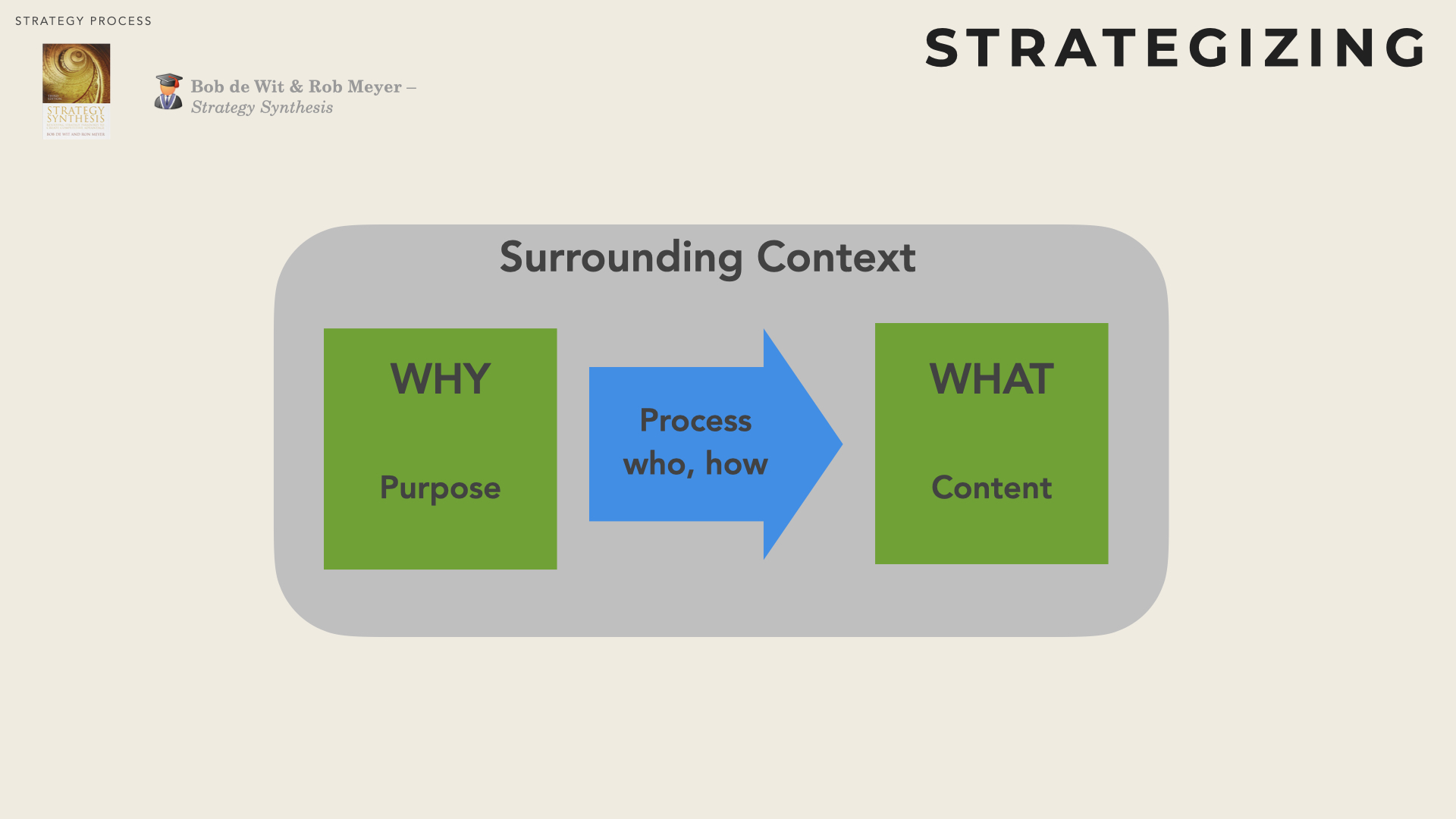
Strategy context, refers to the specific environment (within and outside the firm)in which the strategy process takes place.
Strategy Purpose, as stated by De Wit & Meyer, “Organisations exist to fulfil a purpose, and strategies are employed to ensure that the organisational purpose is realised and making strategies is not an end in itself but a means for reaching special objectives”.
Strategy process, describes the set of activities, their sequencing as well as the roles and responsibilities of the involved stakeholders.
Strategy content, corresponds to the output (or product) of the strategy process, i.e. a formulation of the expected strategy for the firm or a course of action for achieving the firm’s purpose.
The strategy process usually deeply depends on the specific context and purpose of a firm. Likewise, opting for a different process is likely to influence the strategy content.
Analysis, Formulation, Execution
The strategy process is classically decomposed into three steps: the analysis, the formulation and the execution.
With the analysis phase, strategists seek to delineate and understand the situation. Next, in the formulation phase they look for strategic options, rank them and select one. Finally the selected option is implemented in the execution phase.
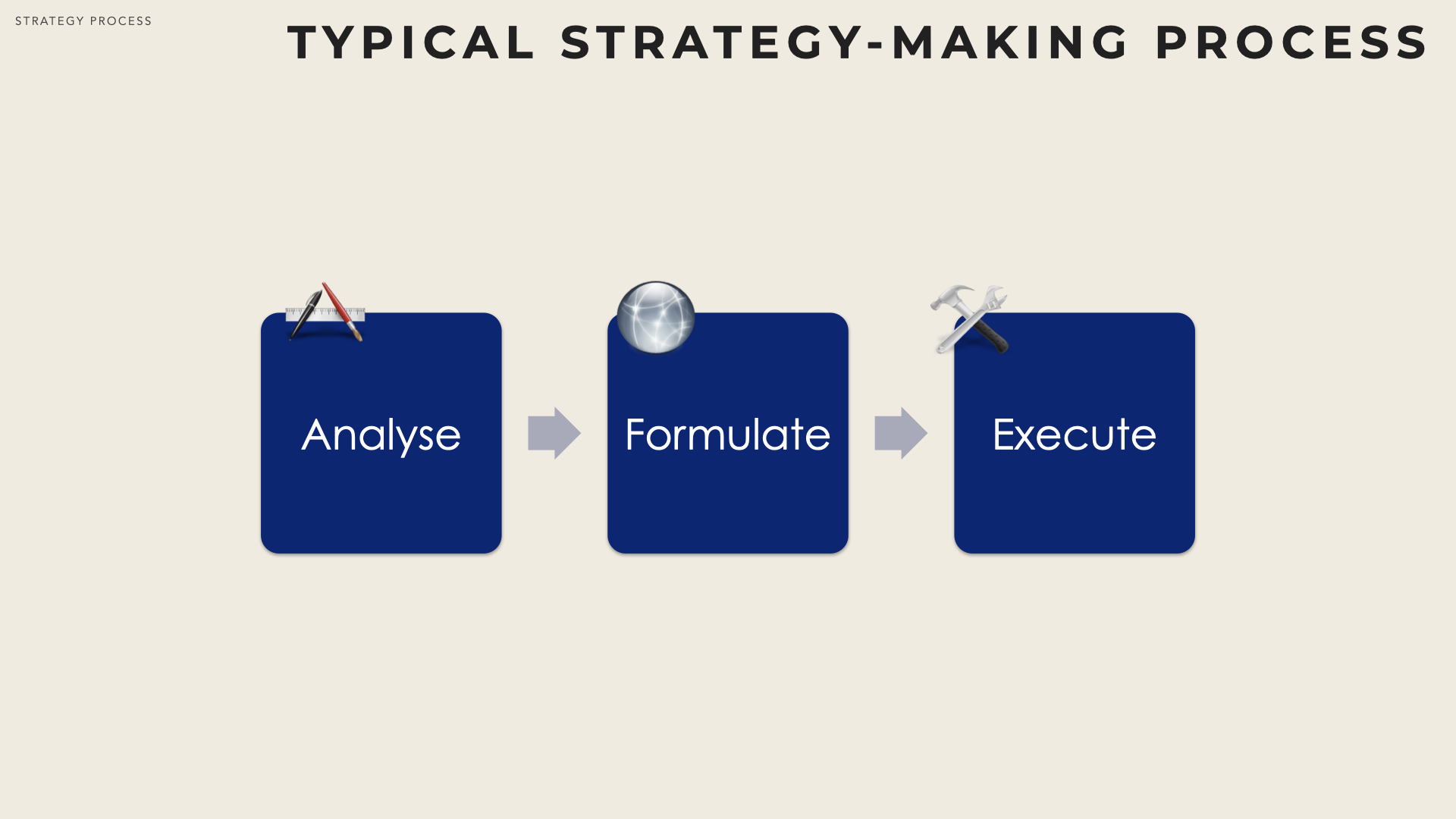
Strategy formation is usually depicted as a three-step process : analysis, formulation and execution. :
Analysis – In a first step, both internal (self evaluation) and external environment must be appraised. The analysis should encompass both macro-environmental and micro-environmental (the industry, competitors, etc) considerations. It aims at gathering facts and figures but also at figuring out trends and possible evolutions. Identification refer to al the activities contributing to a better understanding of the issue what constitute an important opportunity or threat, which is linked to the firm’s mission. Most strategic issues are complex and getting some sort of understanding requires deliberate analyses. Looking at the the environment surrounding a firm is usually called an external assessment, while the internal assessment focuses on the capabilities and internal functioning of the firm.
Formulation – When their landscape is known and understood, firms produce a clear set of recommendations (or strategic plan), with sup- porting justifications. Recommendations may propose to revise and/or update the missions, goals or objectives of the organization. It is usually considered that a good recommendation should be effective in solving the problem(s) while ensuring a good level of ’fit’ between the resources and competences and the external environment. It should also be feasible within a reasonable timeframe, reasonable budget and without overly disruption for the organization. And above all, it should be (made) acceptable to the various stakeholders in the organizations. Formulation is sometimes broken down into two aspects: option generation and selection.
Option generation aims at identifying and articulating potential options or avenues to address the strategic issue.
Option selection consists in choosing among candidate options
Execution – Once approved, a strategy must be effectively and consistently implemented by the organization. Lack of sustainable and consistent commitment is one of the major pitfalls in strategy execution and probably the first reason for strategy implementation failures.
Strategy Elaboration is also a ‘Social Process’
The Strategy Process is often assumed to be linear (things are done sequentially) rational (based on rigorous logic and extensive knowledge) and comprehensive (every thing can be changed at execution time).
In practice however, the three steps are not as sequential as depicted by the usual ’standard process’. Furthermore, it is not uncommon to proceed by successive iterations (a bit of analysis, a bit of formulation, then back to analysis and formulation, etc). “Strategies are formed incrementally, as organizations think and act in small iterative steps, letting strategies emerge as they go along.“ ( [DeWit10] ) .
However many academics and most practitioners now consider that the strategy process is more intuitive & creative than purely rational. “Strategizing is about perceiving and envisioning and imagination & judgment are more important than analysis and logic” ( [DeWit10] ) .
While it can occur, it is also rather rare that a company can fully redesign. “Strategy changes is usually more gradual and fragmented than radical and coordinated”.

Iteration – Conducting a comprehensive analysis before stepping to the formulation stage would be very time consuming and probably inefficient. Usually firms run successive analysis-formulation loops. Candidate strategic moves are identified (formulated) further to a first analysis. Then subsequent analysis-formulation loops are handled, to refine the candidate projects and eliminate some. When projects are considered sufficiently robust and justified, a final recommendation is made to decision makers.
Buy-In – Strategic recommendations usually challenge the status quo and propose to walk out from the established comfort zone. Experience shows that when strategic recommendations are established in isolation from the rest of a firm, they are likely to be (at least at first) rejected by internal stakeholders. Strategists must therefore, leave their ivory tower and make sure that some stakeholders representing the various firm’s Functions (or departments) get involved and familiar with the analysis and formulation as soon as possible. However, internal stakeholders can be very complacent with the current situation and/or extremely reluctant when it comes to breakthrough changes. Strategists may choose to perform some analyses alone (or possibly with external support) to avoid distortions. These results can then be shared with other internal stakeholders to raise their awareness.
Explain – Once established, a strategic recommendation must be explained first to the decision makers, then to internal stakeholders (to get it executed) and also to external stakeholders (customers, suppliers, media, shareholders, rating agencies, etc). It is paramount to make it very simple, comprehensible and as crisp as possible. If you cannot articulate your strategy in a one-minute elevator ride, or put it in a single piece of paper (with no buzzword, no techno-geek stuff and no implicit statement) it is likely that strategy will never get executed.
Story telling – Story telling is inherent to strategic move. It is always a good sign when co-workers and/or external analysts start to ’recite’ the story. However, it would be a mistake to reduce strategy formulation to the production of catch phrases or tag lines. It is not straightforward to craft a simple, compelling story. It is usually the result of a comprehensive and deep strategic analysis.
Feedback – Last but not least, it is always useful to ensure explicit feedback between execution (the strategy that get actually implemented) and formulation (the intended strategy) to control effectiveness. Discrepancies between the two can reflect changes (in the external and or internal environment), which would require adjusting the strategy formulation. It may also be the sign that the intended strategy is not rightly implemented, which also require revisiting the strategy formulation to make sure it is better understood and executed.
Strategy elaboration is also a social process, in so that the involvement and support of all stakeholders must be explicitly built as part of the elaboration of strategy..
Strategy formulation as a four-fold alignment
Classically, the Art of Strategy can be seen as the assessment and alignment of four components:
Market opportunity: what the company might do,
Corporate competences & resources: what the company can do,
Values & aspirations: what the company wants to do,
Acknowledgment of obligations to society: what the company should do.
The strategic options that get implemented, result from matching opportunity and corporate capabilities, provides that they meet the aspiration of the firm at an acceptable level of corporate responsibility.
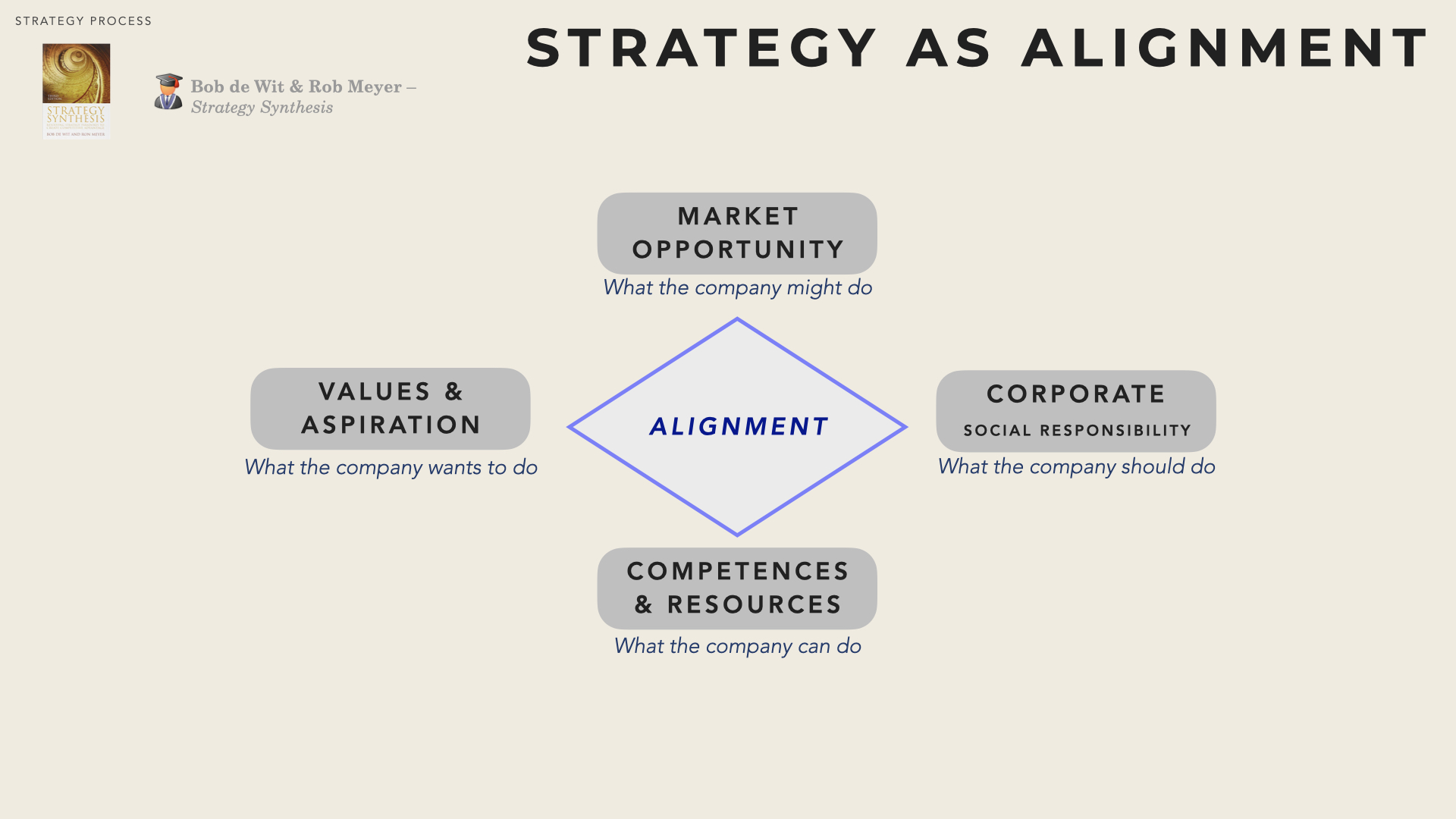
It is the unity, coherence and and internal consistency of a company’s strategic decisions that position the company in its environment and give the firm its identify, its power to mobilise its strengths, and its likelihood of success in the marketplace. - ( [Andrews87] )
Strategic management as Change Management
Reasons for not articulating strategy
While the unity and the coherence of a firm’s strategy can be the result of a deliberate process corporate, it can also be the result of compromise among coalitions backing contrary policy proposals, unspoken consensus, or skillful improvisatory adaptation to external forces.
“Conscious planning of the long-term development of companies has been until recently less common than individual executive responses to environmental pressure, competitive threat, or entrepreneurial opportunity”. ( [DeWit10] )
In that perspective, Strategy becomes unplanned, natural, intuitive, incremental by nature.
A reason for the absence of a deliberate strategic plan can be “the desirability of keeping it confidential for security reasons and ambiguous to avoid internal conflict […] or to avoid resistance or hurting any emotional attachments”.
The main tensions in the strategy process are summarized here-below
| Strategic Thinking | Rational vs intuitive & creative thinking |
| Strategy Formation | Intended vs Emergent strategy |
| Evolution & Change | Radical vs Incremental redesign |
Strategy thinking and cognition
Strategizing involves two nature of mental activities: defining strategic problems and solving strategic problems which broadly cover the following aspects:
Identification sense-making of the situation or problem
Diagnosis understand the structure of the problem and its underlying cause
Formulation derive potential solutions and select the preferred one.
Realise undertake concrete actions to achieve the expected result(s).
De Wit stresses that for some scholars strategic reasoning is dominantly a logical activity that hinge upon strong analytical skills. The course of action is explicitly derived from an in-depth analysis of the facts and available data. However despite their seeking to be comprehensive, rigorous and systematic, strategists will hit some shortcomings and cognitive limitations. As stressed by H. Simon “people act intentionally rational but only limitedly so” ( [Simon57] ) “.
Other thinkers are strong proponents of generative reasoning: creating new perspective, unveiling new insights and find new ways to solve problems. According to them “Creative thinking should be the driving force and logical thinking a supporting means”. Defining and solving strategic problem is primarily a creative activity: questions are ill-defined & highly subjectives and furthermore, the classes of potential solutions are not known in advance (aka wicked problem ( [Ritel73] ) ).
Articulating a strategy then becomes a creative reformulation of the situation. For instance Jim Kecinski (Managing director at Google) stresses that one should “tap into the wisdom of crowds to drive innovation and creativity” - “framebreaking ideas can’t be found, they have to be generated”. Sergey Brin (Google’s co-founder) considers that most successful projects at Google have emerged bottom-up rather than being conceived top-down.
Strategic Change
The alignment of firms with their environment is a dynamic balance. It constantly evolves and firms have to change to stay alive.
While change is pervasive, not all change in firms is strategic in nature. Much of the change witnessed is actually the operational kind (i.e. directed at increasing the performance of the firm within the confines of the existing system) ( [DeWit10] )
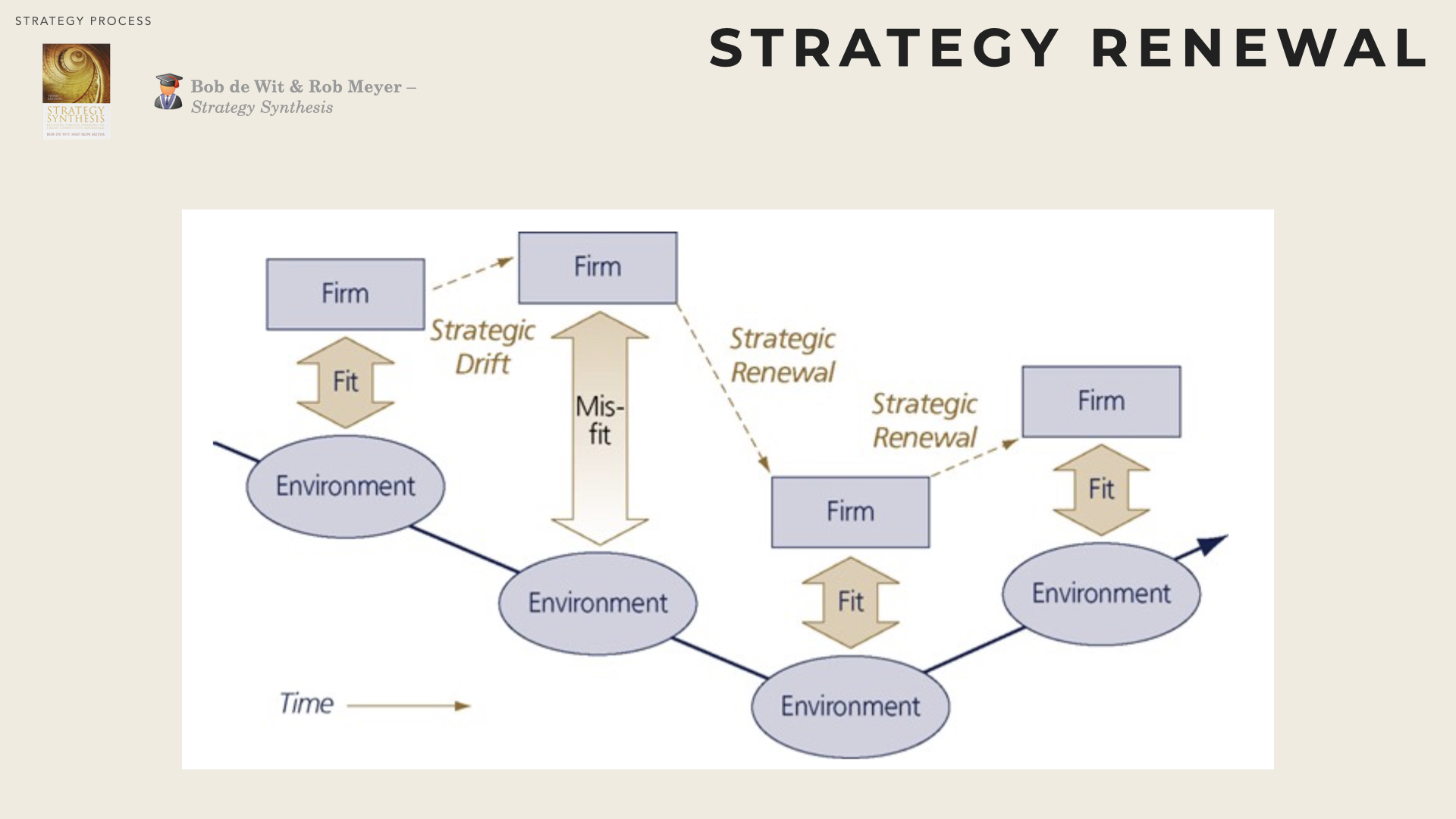
Strategic changes (aka Strategic renewal) have an impact on how a company makes business and/or on how it configures its capabilities. Strategic renewal can be characterized by the magnitude of change (incremental vs step change) and by the pace of change (continuous & evolutionary vs. abrupt & radical).
to achieve strategic renewal it is essential to turn away from the firm’s heritage and to start with a clean slate. On the other hand, to achieve lasting strategic renewal, people in the organisation need time to learn, adapt and grow , building on past experiences, investments and loyalties. ( [DeWit10] )
Big bang approaches (radical and disruptive) may be necessary when organizational rigidity is so deep that small increments can create the momentum and move the needle.

Firms are complex systems.
The business system refers to the way ‘a firm makes money‘: it is a configuration of inputs, outputs (value proposition) and activities (thoughput) intended to create value for customers.
The organisational system refers to ‘the way a firm carries out the business’ (i.e. how the individuals populating the firm have been configured and relate to one another, with the intention of facilitating the business system.)
The organisation system is often further decomposed into its structure (anatomy), its processes (physiology) and its culture (pyschology) ( [Bartlett] ) .
The organisation structure depicts how the organisation is configured in smaller parts and reflects the division of labour (i.e. how to deliver value effectively and efficiently). The structure of an organisation can hinge on its inputs (e.g. structured by core inputs or supply-chain channels), its transformation processes (e.g. structured by nature of value-adding activities, transformation technologies, locations) or its outputs (e.g. by groups of clients, by product-markets, by brands, by distribution channels).
The organisational processes depict the arrangements, procedures, and mechanisms used to control and coordinate the various people and sub-structures. Processes can span the full organisation of by contrast, remain very local to some activities. Not all processes are formalised, and very often there is a full set of implicit processes and routines alongside formal processes.
The organisation culture corresponds to behavioural patterns shared by the members of an organisation. It includes values and norms, which play as a common interpretative filter of the surrounding environment.
Culture can act as a strong integration mechanism, controlling and coordinating people’s behaviour, by getting them abide by ‘the way we do things around here’. ( [DeWit10] )
Some sort of integration mechanism is needed to balance the horizontal differentiation of tasks. The formal authority (hierarchy) is one of those.
Give Meaning
The commander intent
Even when it is explicitly formulated, a strategy does include detailed actions for all stakeholders. On the contrary, it should focus on top level considerations and promote alignment, while leaving a lot of freedom and leeway to the people in charge of executing.
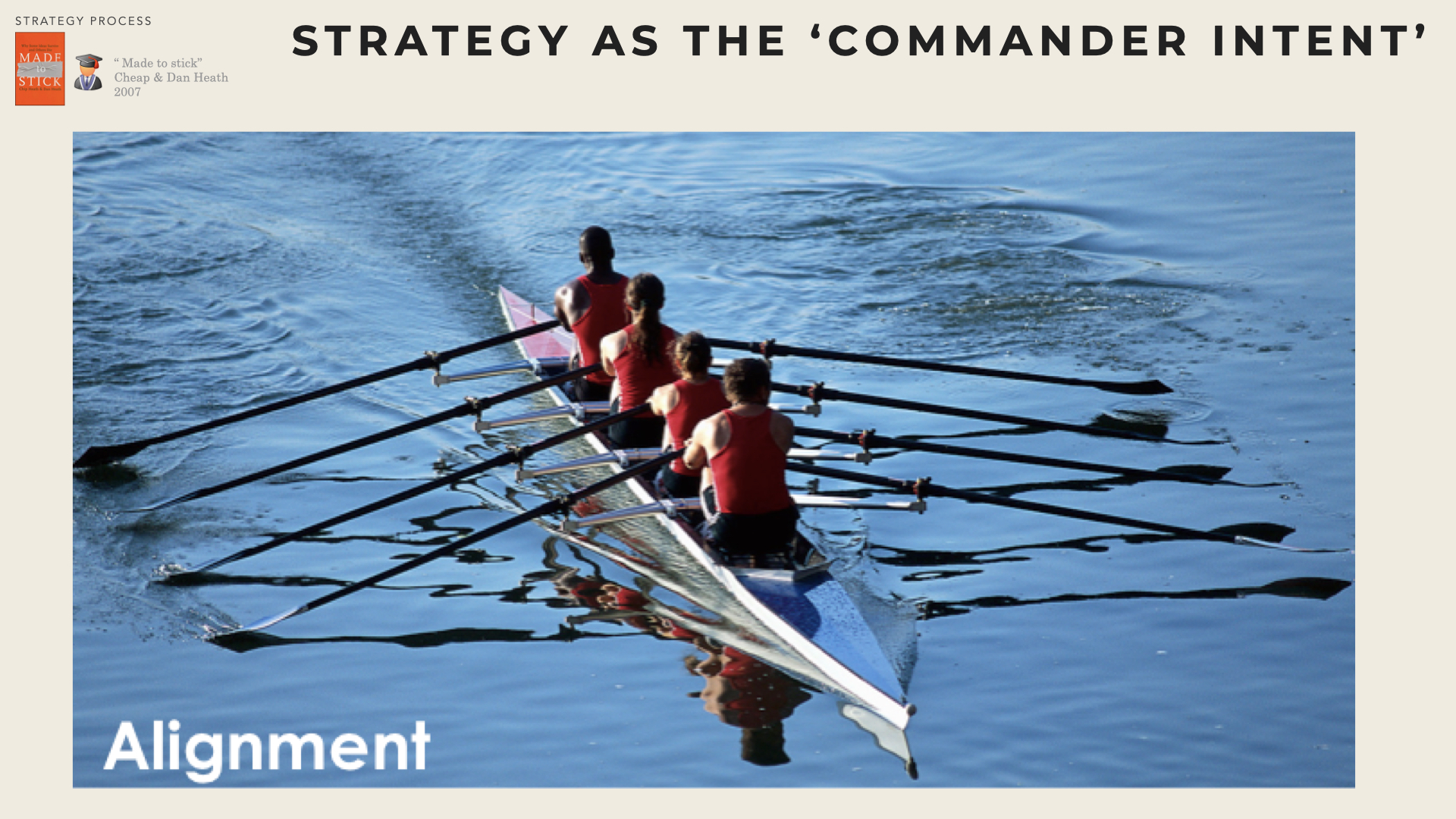
D. Sull & K.M. Eisenhardt ( [Sull15] ) have rightly pointed out that if an organization’s strategy lives on the shelf then this organization has a problem. How to bridge the gap between strategy and execution? According to them, by polishing simple statements that help making on-the-spot decisions and adapting to rapidly changing circumstances.
They argue that while a checklist or any other process adherence technique is usually well adapted in repetitive situation (e.g. safety control) to ensure the activities alignment with corporate objectives. Agreeing on a simple ’principle’ is more adequate in more dynamic environment however, where flexibility is important. Process operators can then decide the most appropriate action to cope with the principle, subject to the actual circumstances.
In A.C. Hax’s words ( [Hax01] ) the true purpose of the strategy statement is to capture and clearly articulate our intent. Strategy is a fundamental vehicle to communicate our sense of direction, both inside and outside the organization. It aims to give purpose and direction to an organization and end up with the proper implementation of a well-designed strategy.
This simple idea of not trying to fix in advance every tiny detail was made famous by D. Eisenhower who claimed “No plan survive the first contact with the enemy”.
Chip & Dan Heath ( [Heath07] ) hammer on the message. The planning process forces people to think through the right issues, however even if you may start off trying to fight your plan, the enemy gets a vote.
In the 80’s the Army invented the concept of CI (Commander’s intend): a crisp, plain-talk statement, specifying the goal, the desired end-state. You can lose the ability to execute the original plan but you never lose the responsibility of executing the CI.
The commander’s intend should phrase something like ‘if we do nothing else, we must: do xxx’ or something like ‘the single most important thing is: xx’.
Strategy here must give a sense of direction “If organisations didn’t decide where they wanted to go, any direction and activity would be fine - Without objectives and plans, organisations would be adrift.” ( [DeWit10] )